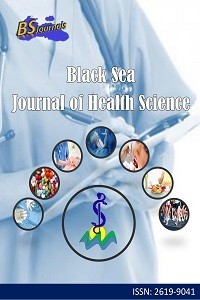Evaluation of Preoperative Anemia Prevalence in Elective Minor Surgery in Children
Evaluation of Preoperative Anemia Prevalence in Elective Minor Surgery in Children
___
- Adenekan AT, Faponle AF, Oginni FO. 2012. Preoperative haematological investigations in paediatric orofacial cleft repair: Any relevance to management outcome?. Afr J Paediatr Surg, 9: 52-56.
- Ajimura FY, Maia ASSF, Hachiya A. 2005. Preoperative laboratory evaluation of patients aged over 40 years undergoing elective non-cardiac surgery. Sao Paulo Med J, 123(2): 50-53.
- Basel A, Bajic D. 2018. Preoperative evaluation of the pediatric patient. Anesthesiology Clin, 36(4): 689–700.
- Çelikol Ş, Büyük ET, Yıldızlar O. 2019. Children’s pain, fear, and anxiety during invasive procedures. Nursing Sci Quart, 32(3): 226-232.
- Gerçeker GÖ, Ayar D, Özdemir EZ. 2018. The impact of the difficult vascular access, fear, and anxiety level in children on the success of first-time phlebotomy. J Vascul Acc, 19(6): 620-625.
- Goel R, Cushing MM, Tobian AA. 2016. Pediatric Patient Blood Management Programs: Not Just Transfusing Little Adults. Transfus Med Rev, 30(4): 235-241.
- Goobie SM, Gallagher T, Gross I. 2019. Society for the advancement of blood management administrative and clinical standards for patient blood management programs. Pediatr Anesth, 29: 231-236.
- Ioannou IA, Newton R, Clevenger B. 2019. Prevalence of preoperative anemia in pediatric surgical patients and its impact on perioperative blood transfusion. Edorium J Anesth, 5: 100019A05II2019.
- Janus J, Moerschel SK. 2010. Evaluation of anemia in children. American Family Physic, 81(12): 1462-1471.
- Kannaujia AK, Gupta A, Verma A. 2020. Importance of routine laboratory investigations before elective surgery. Discoveries, 8(3): e114.
- Karaman S, Karakaş Z. 2013. Anemik çocuğa yaklaşım. Çocuk Derg, 13(4): 131-137.
- Lin Y. 2019. Perioperative anemia-screening clinics. Hematol Am Soc Hematol Educ Prog, 1: 570-576.
- Mallick MS. 2006. Is Routine preoperative blood testing in children necessary?. Saudi Med J, 27(12): 1831-1834.
- Meyer HM, Torborg A, Cronje L. 2020. The association between preoperative anemia and postoperative morbidity in pediatric surgical patients: A secondary analysis of a prospective observational cohort study. Pediatr Anesth, 30: 759-765.
- Michota FA, Frost SD. 2004. The preoperative evaluation: use the history and physical rather than routine testing. Cleve Clin J Med, 71(1): 63-70.
- Mirza MA, Mirza MB, Askari MR. 2018. Optimum hemoglobin level for daycare surgery in children. J Surg Pakistan, 23(2): 72-75.
- Nieto RM, De Leon LE, Diaz DT. 2017. Routine preoperative laboratory testing in elective pediatric cardiothoracic surgery is largely unnecessary. J Thorac Cardiovasc Surg, 153: 678-685.
- Orbatu D, Alaygut D, Onder SZ. 2020. Evaluation of nutritional anemia in Middle Eastern migrant and refugee children. Turkish J Pediatr Dis, 14: 244-248.
- Soares DdeS, Brandão RR, Mourão MR. 2013. Relevance of routine testing in low-risk patients undergoing minor and medium surgical procedures. Rev Bras Anestesiol, 63(2): 197-201.
- Somy C, Sarah ED, Jecko T. 2019. Surgical decision making around paediatric preoperative anaemia in low-income and middle-income countries. Lancet Child Adolesc Health, 3(11): 814-821.
- TARDPAÇG. 2015. Türk Anesteziyoloji ve Reanimasyon Derneği Pediatrik Anestezi Çalışma Grubu, Çocuk hastada preoperatif değerlendirme kılavuzu. İstanbul, Turkey, pp: 6. URL: https://www.tard.org.tr/assets/kilavuz/11.pdf (access date: August 10, 2021).
- WHO. 2011. World Health Organization. Haemoglobin Concentrations for the Diagnosis of Anaemia and Assessment of Severity. Geneva, Switzerland. URL: https://www.fao.org (access date: August 01, 2021).
- WHO. 2015. World Health Organization. The global prevalence of anaemia in 2011. Geneva: World Health Organization, URL: https://www.fao.org (access date: August 01, 2021).
- Yayın Aralığı: Yılda 4 Sayı
- Başlangıç: 2018
- Yayıncı: Cem TIRINK
Rotavirus Konulu Yayınlara Global Bakış
Bibliometric Analysis of Publications on Pulmonary Rehabilitation
Tuğba GÖNEN, Elif DİNLER, Deniz KOCAMAZ, Yavuz YAKUT
Nöral Yaşlanma ile İlişkili Süreçlerin Nöroplastisite Üzerine Etkisi
İrem Gülfem ALBAYRAK, Elif MUTLU
Nurcan UZDİL, Mahmut EVLİ, Bülent TOKGÖZ
Doğal Öldürücü Hücre Aktivitesinde İmmunomodulatör Etki Gösteren Moleküller
Hüseyin KAYA, Seda KUŞOĞLU GÜLTEKİN, Belkis ATASEVER ARSLAN
Sevim BALTALI, İlkay CEYLAN, Veysel ERDEN
Factors Affecting Morbidity and Mortality in Gastrectomy Cases with Splenectomy
Tolga KALAYCI, Ümit Haluk İLİKLERDEN, Çetin KOTAN
Etiology and Histopathology of Alzheimer’s Disease and Current Approaches
Fikri ERDEMCİ, Fırat AŞIR, Fatih TAŞ
